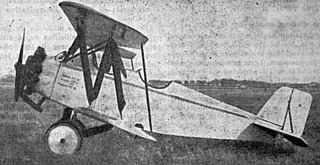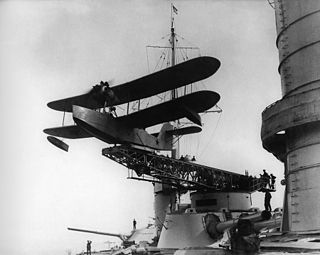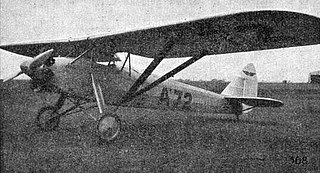
The Focke-Wulf Fw 44 Stieglitz ("Goldfinch") is a 1930s German two-seat biplane. An early design by Kurt Tank, it was produced by the Focke-Wulf company as a pilot training and sports flying aircraft. It was also eventually built under license in several other countries.

The Albatros L 68 Alauda was a two-seat German trainer aircraft of the 1920s. It was a single-engine biplane of conventional configuration that seated the pilot and instructor in tandem, open cockpits. The wings were of unequal span and had a pronounced stagger.

The Arado S I was a biplane trainer built in Germany in 1925. The first of three prototypes was powered by a Bristol Lucifer radial engine, while the other two Arado S.Ia aircraft were fitted with the Siemens-Halske Sh 12. The Siemens-Halske Sh 11 powered the Arado S III, a virtually identical aircraft of which only a single prototype was constructed and sold to Turkey.
The Arado W 2 was a two-seat twin-engine seaplane trainer developed for the DVS in 1928. It was a cantilever monoplane with a fabric-covered steel tube fuselage that accommodated the pilot and instructor in tandem open cockpits. The undercarriage consisted of two pontoons carried on steel struts.

Klemm L 25, later Klemm Kl 25 was a successful German light leisure, sports and training monoplane aircraft, developed in 1928. More than 600 aircraft were built, and manufacturing licenses were sold to the United Kingdom and the United States.

The Hirtenberg HS.9 was an Austrian two-seat touring or training aircraft of the late 1920s and early 1930s.

The Klemm Kl 36 was a 1930s German four-seat cabin touring and competition monoplane designed and built by Klemm.

The Hanriot H.41 was a military trainer aircraft produced in France in the 1920s. It was a further development in the family of aircraft that had commenced with the HD.14 in 1920, and incorporated a number of design features that had been developed for other members of that family. Like those other aircraft, however, it was a conventional, two-bay biplane with unstaggered wings of equal span.

The Hanriot HD.32 was a military trainer aircraft built in France in the 1920s. Derived from the HD.14 and sharing the same basic configuration as it, the HD.32 was a substantially revised design, with redesigned tailplane, undercarriage, and wings of shorter span. The HD.14's wooden construction was replaced in part with metal structure.

The Heinkel HD 39 was a special-purpose cargo aircraft developed in Germany in the 1920s to distribute the Berlin newspaper B.Z.. It was a conventional single-bay biplane with staggered wings of equal span, and a fuselage that nearly filled the interplane gap. The pilot sat in an open cockpit, and the undercarriage was of fixed, tailskid type with divided main units. The sole example of the type was built after Ernst Heinkel found out, by chance, that B.Z. required such an aircraft and had ordered two machines from Albatros. Heinkel convinced publisher Ullstein-Verlag to purchase a third aircraft from his firm.

The Heinkel HD 55 was a biplane flying boat produced in Germany in the early 1930s for use as a reconnaissance aircraft aboard Soviet warships. The design was based on the HD 15 mail plane of 1927 and was a conventional design for its time, with equal span, unstaggered wings, and an engine mounted tractor-wise on struts above the pilot's open cockpit. A second open cockpit was added on the rear fuselage to provide a position for a tail gunner.

The Hopfner HS-8/29 was a utility aircraft built in Austria in the late 1920s based on the Hopfner HS-5/28. It used a modernised version of its predecessor's airframe, being a conventional, parasol-wing monoplane with seating for two occupants in tandem, open cockpits. The landing gear was of fixed, tailskid type with divided main units. The first prototype used the same Walter NZ 85 engine that the later HS-5/28s had used, but this was followed by 14 production examples with Siemens engines, and a single prototype with a de Havilland Gipsy III.

The Henschel Hs 122 was a German army cooperation/reconnaissance aircraft of the mid-1930s, radial-engined and with a parasol wing. Though only pre-production variants entered service, the Hs 122 led on to the Hs 126 which was produced in large numbers.

The BFW M.21 was a single-engined biplane trainer designed by Willy Messerschmitt for the German Ministry of Transport. It was one of only two biplanes Messerschmitt designed, neither reaching production.
The Siemens-Schuckert R.III was a prototype bomber aircraft built in Germany during World War I. It was one of six aircraft based on the Siemens-Schuckert R.I that were originally intended to be identical, but which each developed in a different direction and were designated as different aircraft types by the German Inspectorate of Flying Troops. The aircraft's development was impeded by the unreliability of its Maybach HS engines, and when it was eventually accepted for military service, it was only in a training role.
The Heinkel Doppeldecker 43 was a prototype German fighter aircraft of the 1930s. A single-engined, single-seat biplane, the HD 43 was designed to meet a secret German Reichswehr requirement for a single-seat fighter. It had two-bay wooden wings with a steel-tube fuselage, and was powered by a 750 hp (600 kW) BMW VI engine. The single prototype flew in 1931.

The Dietrich DP.II Bussard was a 1920s German two-seat training biplane designed by Richard Dietrich and built by the Dietrich-Gobiet Flugzeugwerke as Kassel.

The Focke-Wulf GL 18 was a 1920s German light transport monoplane, designed and built by Focke-Wulf.
The Heinkel HD 30 was a biplane reconnaissance seaplane developed by Ernst Heinkel Flugzeugwerke.
The Heinkel HD 41 was a reconnaissance developed in Germany in the 1920s.















